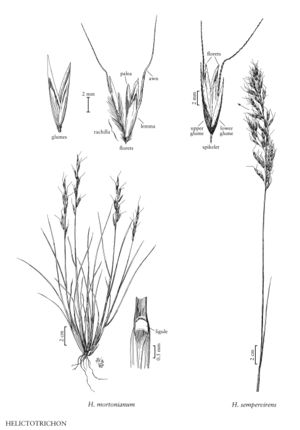familyPoaceae
subfamilyPoaceae subfam. Pooideae
tribePoaceae tribe Poeae
genusHelictotrichon
speciesHelictotrichon sempervirens
Difference between revisions of "Helictotrichon sempervirens"
Common names: Blue oatgrass
Synonyms: Avena striata unknown
Treatment appears in FNA Volume 24. Treatment on page 701.
FNA>Volume Importer |
FNA>Volume Importer |
||
| Line 19: | Line 19: | ||
-->{{Treatment/Body | -->{{Treatment/Body | ||
| − | |discussion=<p | + | |discussion=<p>Helictotrichon sempervirens is a native of the southwestern Alps in Europe, where it grows on rocky soils and in stony pastures. In the Flora region, it is frequently grown as an ornamental species; it is not established in the region.</p> |
|tables= | |tables= | ||
|references= | |references= | ||
| Line 35: | Line 35: | ||
|basionyms= | |basionyms= | ||
|family=Poaceae | |family=Poaceae | ||
| + | |illustrator=Linda A. Vorobik and Hana Pazdírková | ||
|reference=None | |reference=None | ||
|publication title= | |publication title= | ||
|publication year= | |publication year= | ||
|special status= | |special status= | ||
| − | |source xml=https:// | + | |source xml=https://bibilujan@bitbucket.org/aafc-mbb/fna-data-curation.git/src/314eb390f968962f596ae85f506b4b3db8683b1b/coarse_grained_fna_xml/V24/V24_994.xml |
|subfamily=Poaceae subfam. Pooideae | |subfamily=Poaceae subfam. Pooideae | ||
|tribe=Poaceae tribe Poeae | |tribe=Poaceae tribe Poeae | ||
Revision as of 16:10, 30 October 2019
Culms 30-100(150) cm. Ligules 0.5-1.5 mm, truncate, ciliate; blades 15-60 cm long, 2-4 mm wide, usually convolute and 0.9-1.5 mm in diameter, glaucous, scabridulous, basal blades deciduous when dead. Panicles 8-20 cm; branches ascending, with 3-7(10) spikelets. Spikelets 10-14 mm, with 3(5) florets. Glumes subequal to unequal; lower glumes 7-10 mm; upper glumes 10-12 mm; lowest lemmas 7-12 mm, awns about 15 mm; distal lemmas unawned; anthers about 5 mm. 2n = 28, 42.
Discussion
Helictotrichon sempervirens is a native of the southwestern Alps in Europe, where it grows on rocky soils and in stony pastures. In the Flora region, it is frequently grown as an ornamental species; it is not established in the region.
Selected References
None.
Lower Taxa
None.
